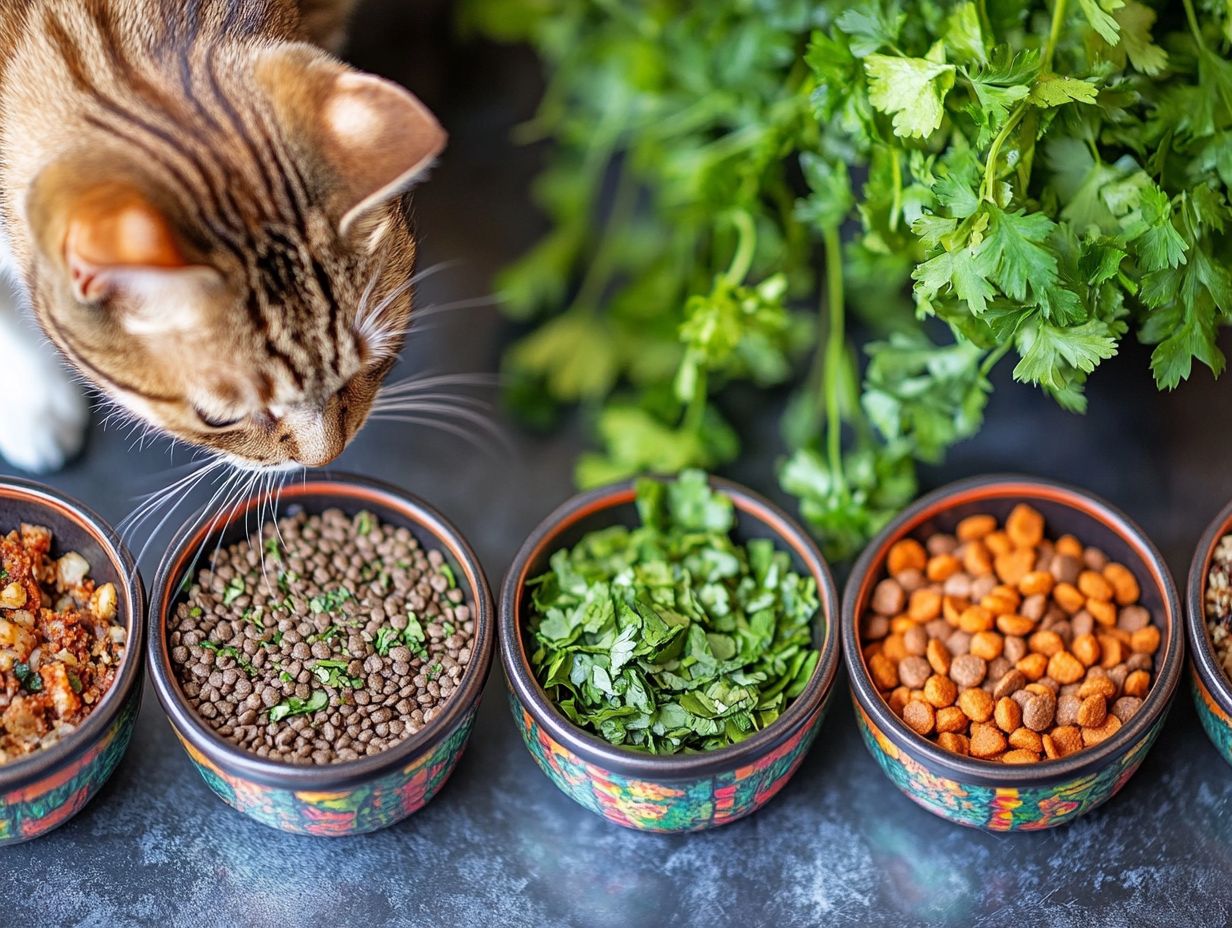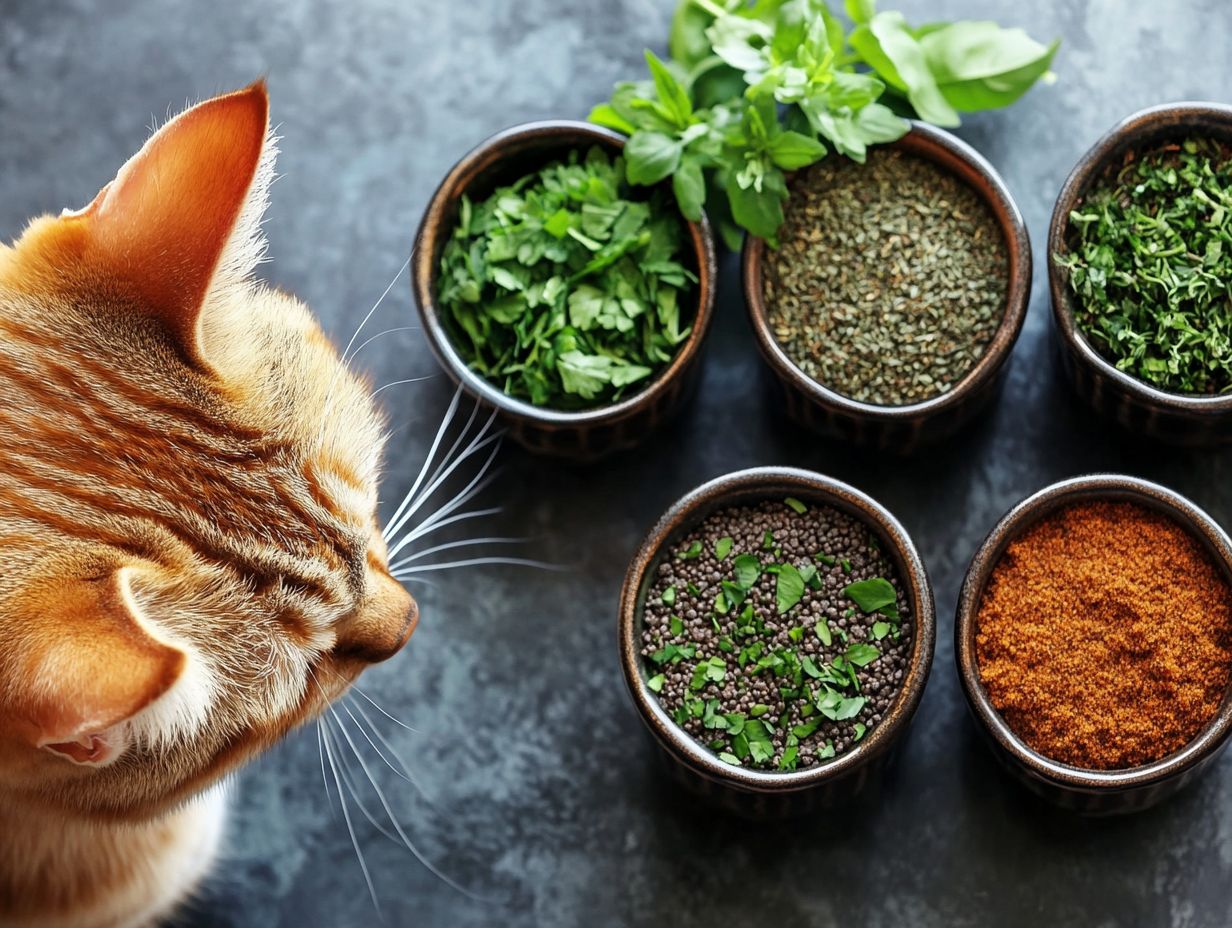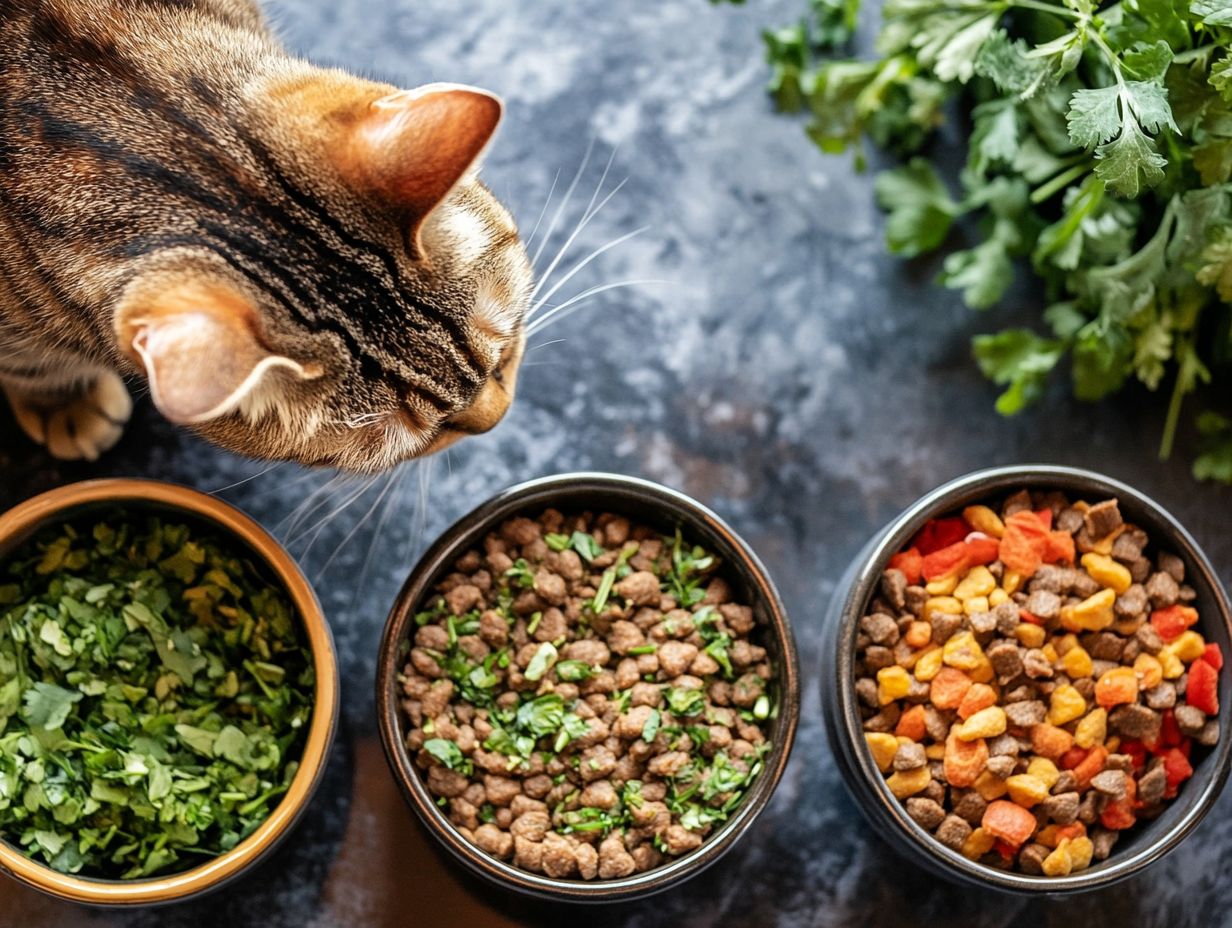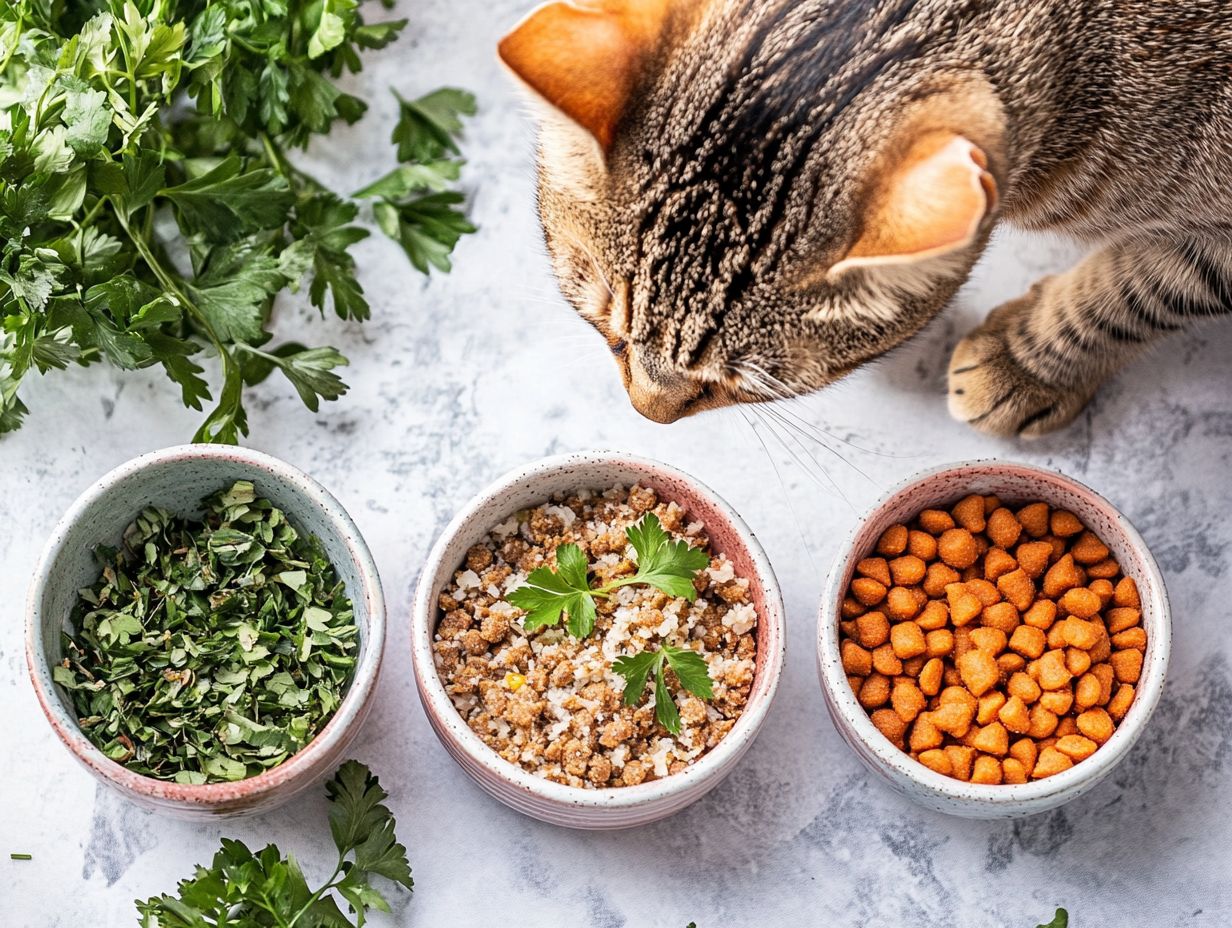Cats are obligate carnivores, meaning their diet should be rich in protein to support their health and vitality. Before considering homemade diets, it’s vital to consult a veterinary nutritionist to ensure the diet meets all necessary nutritional standards.
If you’re considering a homemade approach to feeding your feline friend, consult a veterinary nutritionist to ensure that your homemade meals meet the specific nutritional needs of your cat!
This article explores the significance of a high-protein diet for cats, the benefits of homemade cat food, including cat food recipes that include essential nutrients and are balanced according to AAFCO standards, and crucial factors to keep in mind before you start preparing meals in your kitchen.
Additionally, five satisfying, vet-approved recipes are shared that are sure to please even the pickiest eaters.
Ready to elevate your cat’s dining experience? Let’s get started!
Key Takeaways:

The Importance of a High-Protein Diet for Cats
A high-protein diet is essential for optimal feline health because cats are obligate carnivores that require a protein-rich diet to meet their specific metabolic needs. Inadequate protein sources or imbalanced diets can lead to potential nutritional deficiencies that negatively affect your cat’s health.
It is crucial to consider the sources of protein, ensuring they adhere to the minimum standards set by AAFCO guidelines and do not result in nutritional deficiencies that could negatively affect your cat’s health. High-quality protein sources, such as turkey and mackerel, enhance the nutritional value of homemade cat food, making protein one of the most important components of a cat’s diet.
What Makes Homemade Cat Food a Good Option?
Homemade cat food offers numerous benefits, including the ability to customize recipes to meet specific dietary requirements. It also allows for the creation of a balanced diet that includes a variety of ingredients, promoting overall feline health.
Wholesome ingredients such as turkey, pumpkin, and coconut oil can be combined to create nutritious meals tailored to specific dietary needs, while avoiding potential allergens found in commercial kibble. Always check for potential allergens and consult a veterinarian before introducing new ingredients like coconut oil, which may not be suitable for all cats. Additionally, following cooking instructions that emphasize food safety can help minimize the risks of foodborne pathogens.
Things to Consider Before Making Homemade Cat Food
Before making homemade cat food for your pet, several factors should be considered, as they significantly affect both your cat’s well-being and the practicality of meal preparation. Consulting with a holistic vet blend or using premix supplements like Balance IT, EZComplete, or Alnutrin can ensure a balanced diet. It is essential to validate recipes against established veterinary guidelines to ensure nutritional adequacy.
Nutritional Requirements: Understanding the nutritional needs of cats is the most crucial aspect of preparing food for your feline friend. Cats are obligate carnivores, meaning they require nutrients found in animal products, such as proteins and amino acids. A balanced meal must include not only meat and animal-based products but also other food groups, all prepared in a specific manner to prevent nutritional deficiencies. Consider using veterinary-approved supplements to ensure that your homemade diet meets all nutritional requirements.
Food Safety and Hygiene: When preparing meals that involve raw meat products, the risk of foodborne pathogens increases for both your cat and household members, which is a common concern with homemade meals. It is essential to prioritize food safety and hygiene by ensuring proper food storage, sanitization, and cooking processes. Foodborne pathogens can lead to unpleasant symptoms in cats, such as vomiting, diarrhea, and fever.
Cost and Time: Homemade cat food can often be more expensive than high-quality commercial options. Additionally, those who choose to prepare homemade meals must consider the time required for regular meal preparation.
1. Nutritional Requirements for Cats
The nutritional requirements for cats are complex and primarily centered around their need for high protein content, essential nutrients like taurine, and a variety of ingredients to promote overall feline health. It is crucial to recognize that cats obtain their necessary nutrients mainly from animal-based sources, highlighting the importance of including meat in their diet. Consulting with a veterinarian to establish a balanced diet tailored to individual health needs, especially for cats with specific health conditions, is highly recommended.
Finally, regularly review the latest research and guidelines on feline nutrition, acknowledging that veterinary knowledge and recommendations may evolve over time.
Taurine, an amino acid vital for heart function and vision, is often deficient in plant-based foods, making it essential to incorporate meats such as chicken or beef into their meals. Since cats are obligate carnivores, their diets must primarily consist of animal-source proteins. While some ingredients like vegetables can be included, they should not be the primary component of a cat’s diet. Essential fatty acids play a significant role in maintaining a healthy coat and skin, while specific vitamins support their immune system and overall vitality. For more information on these nutritional standards, refer to authoritative sources like AAFCO and WSAVA.
Therefore, when crafting homemade recipes, it is important to pay attention to these nutritional specifics. Protein sources should be varied to provide a broader array of amino acids, and the balance of fats and vitamins must be carefully managed to meet a cat’s unique dietary needs. However, consider consulting with veterinary professionals before making homemade diets a staple, especially for cats with health conditions, to avoid potential nutrient deficiencies or imbalances.
2. Food Safety and Hygiene

Food safety and hygiene are essential when preparing homemade cat food, as improper handling can result in contamination from foodborne pathogens that may harm your cat’s health. Adhering to strict cooking instructions and cleanliness practices is crucial for preventing these risks and ensuring that the meals you prepare are safe and healthy.
To achieve this, several best practices should be incorporated throughout the preparation process. For instance:
- Always wash your hands before and after handling ingredients.
- Use separate cutting boards for meats and vegetables to avoid cross-contamination.
- Ensure that all food ingredients are fresh and stored at the appropriate temperature, as improper storage can encourage bacterial growth. Properly store homemade cat food in airtight containers and refrigerate or freeze to prevent spoilage.
- Be aware of signs of spoilage, particularly for meats, such as off smells or discoloration.
- Cooking meat to the recommended temperatures also helps eliminate harmful pathogens.
- Always clean utensils and surfaces with hot, soapy water after cooking to create a safer and more hygienic environment for future meal preparation.
3. Cost and Time Commitment
Assessing the cost and time commitment required for homemade cat food is essential for pet owners considering this option, as it demands careful planning and budgeting to ensure sustainability. While homemade meals can be healthier and better suited to a pet’s specific needs, they also require a significant investment of time for preparation and cooking, along with consistent purchases of high-quality ingredients.
When comparing these factors to commercial options, it becomes evident that although the upfront costs and time associated with pre-packaged foods may be lower, the accumulated costs over an extended period are often much higher. Homemade recipes typically allow for the bulk purchase of staple ingredients, which can reduce overall expenses.
Designating one day each week for meal preparation can alleviate the burden of this time commitment. Additionally, using bulk storage solutions and preparing larger quantities can help pet owners provide healthy meals without significantly disrupting their schedules, while still reaping the benefits of homemade meals in terms of cost and time efficiency.
5 High-Protein Homemade Cat Food Recipes
High-protein homemade cat food recipes are a rewarding way to address a cat’s specific dietary needs while ensuring they receive essential nutrients and prevent nutritional deficiencies for optimal health. However, be mindful of special dietary considerations for cats with conditions like kidney disease or diabetes, as certain nutrient profiles can be beneficial or harmful for these conditions.
Recipes that include ingredients like turkey and pumpkin or fish and chicken effectively satisfy a cat’s high-protein dietary requirements.
1. Chicken and Vegetable Stew
Chicken and Vegetable Stew is an excellent homemade cat food option that is high in protein. This recipe not only offers protein from the chicken but also provides fiber and vitamins from the vegetables, enhancing your cat’s overall health.
To prepare this nutritious dish, gather the following ingredients:
- 1 pound of boneless, skinless chicken breast
- 1 cup of diced carrots
- 1 cup of peas
- 1 cup of chopped green beans
- 4 cups of low-sodium chicken broth
- 1 teaspoon of olive oil
Begin by sautéing the chicken in olive oil over medium heat until it turns golden brown. Next, add the chopped vegetables and broth, bringing the mixture to a gentle simmer. Allow it to cook for about 20-25 minutes, until the chicken is fully cooked and the vegetables have softened. Once the stew has cooled, shred the chicken and stir everything together for a delicious and wholesome cat meal.
This stew not only meets your cat’s dietary needs but also provides hydration and supports digestive health. Additionally, consider if supplements may be necessary to ensure a balanced diet; always consult a veterinarian for safe dosages and recommendations.
2. Tuna and Egg Omelette
Disclaimer: Before making any dietary changes for your cat, particularly for those with specific health conditions, it is crucial to consult with a veterinarian. Additionally, feeding tuna regularly can pose risks such as mercury exposure; consider alternatives like chicken or turkey.
A Tuna and Egg Omelette is a quick and easy recipe that offers a significant boost of protein and essential nutrients, making it an excellent choice for a homemade cat food diet. This dish is simple to prepare and serves as a great source of protein, which is vital for supporting a cat’s overall health. It is important to note that taurine, essential for a cat’s health, is primarily obtained from animal-based proteins; this recipe should not be a staple but rather an occasional treat.
To create this nutritious meal, you will need:
- one can of tuna (packed in water)
- two eggs
- a small amount of olive oil for cooking (use in moderation, as fats should be balanced for cats)
Begin by whisking the eggs in a bowl until they are fully combined, ensuring they are fully cooked to eliminate the risk of salmonella. Then, add the drained tuna, flaking it into small pieces.
Next, heat the olive oil in a non-stick skillet over medium heat. Pour in the egg and tuna mixture, cooking for about 3-4 minutes on each side until the egg is fully cooked.
Both fish and eggs are not only excellent sources of protein but also provide essential fatty acids, vitamins, and taurine that contribute to a shiny coat and healthy skin for your cat. Including chicken and liver in your cat food recipes can also enhance its nutritional profile. However, ensure that the liver comes from a reliable source to avoid toxins, and consider the importance of variety in protein sources.
3. Beef and Liver Pâté

Beef and liver pâté is a nutrient-dense food that cat owners can easily prepare at home, providing a delicious blend of flavors and high protein content essential for feline health. This recipe specifically highlights liver, which is rich in vitamins and minerals, ensuring that your cat receives a balanced meal with essential nutrients for feline nutrition foundation. Please remember to balance homemade diets with appropriate supplements to avoid nutritional deficiencies.
This flavorful pâté is made with high-quality beef liver, ground beef, fresh herbs, and a splash of low-sodium chicken broth. To prepare the dish, the liver is finely chopped, and the ground beef is browned in a skillet until fully cooked. After cooling, the beef is mixed with the liver and broth in a food processor until it reaches your desired smoothness. Consider adding premix supplements to ensure nutritional completeness and prevent deficiencies.
Not only does the liver enhance the flavor of the pâté, but it also provides vital nutrients such as iron and vitamin A, which support vision and bolster the immune system in cats. This makes it a tasty and nutrient-rich option for your feline friend.
4. Salmon and Sweet Potato Mash with Sardines
Salmon and Sweet Potato Mash is a delicious homemade cat food recipe that combines the rich flavor of salmon with the nutritional benefits of sweet potatoes and sardines. This dish offers essential omega-3 fatty acids and dietary fiber, making it high in protein while promoting healthy digestion and skin. It is an excellent choice for pet owners who want to enhance their cat’s diet with fresh, whole ingredients that support overall well-being. Note that some cats may have allergies or sensitivities to sweet potatoes.
The preparation is quite simple. Start by thoroughly cooking the salmon, either by baking or steaming it until it is flaky and tender. Meanwhile, peel and boil the sweet potatoes until they are completely soft, then mash them into a creamy consistency. Add a drizzle of coconut oil to enhance flavor and nutritional value.
When combined, these ingredients create a delightful meal that not only pleases a cat’s palate but also provides vital nutrients, contributing to a shinier coat, stronger muscles, and improved energy levels.
5. Turkey and Quinoa Bowl with Pumpkin
The Turkey and Quinoa Bowl is a nutritious homemade cat food recipe that combines lean turkey, pumpkin, and quinoa, resulting in a balanced meal rich in high-quality protein and essential amino acids. This dish not only meets your cat’s dietary needs but also introduces a variety of unique ingredients. Using approximately one cup of cooked quinoa and half a pound of ground turkey, this meal provides the essential nourishment that feline companions require.
To prepare the dish, brown the ground turkey in a skillet over medium heat until it is fully cooked, ensuring that no added oils or spices that could be harmful are included. Once the turkey is ready, mix in the cooked quinoa along with finely chopped vegetables such as carrots or peas for added vitamins. Be aware that some cats may have sensitivities to quinoa. This recipe not only helps maintain your cat’s muscle health but also supports their overall energy levels.
Rich in fiber and low in fat, these ingredients work together to promote healthy digestion and skin, contributing to a well-rounded diet that helps your furry friends thrive.
How to Transition Your Cat to a Homemade Diet Safely
When introducing new foods, it’s important to do so gradually and monitor your cat for any adverse reactions. Appropriate portion sizes should be considered based on your cat’s weight and dietary needs. Store prepared food safely by refrigerating it and consuming it within 3-4 days, and always check for signs of spoilage. Avoid feeding cats toxic ingredients such as onions and garlic.
Transitioning your cat to a homemade diet requires careful planning and a gradual introduction to ensure their comfort and acceptance, ultimately supporting optimal feline health. Consulting a veterinary nutritionist can provide additional insights into meeting your cat’s dietary needs. It’s essential to recognize that cats are obligate carnivores, meaning they need specific animal-source proteins to thrive. Diets lacking these proteins can lead to serious health issues.
It is important to introduce homemade meals slowly into your cat’s feeding schedule, allowing them to adjust to the new diet while also enabling you to monitor their reactions to the new ingredients. Be aware that common deficiencies in homemade diets, such as taurine and calcium, can pose risks. Utilizing veterinary-approved supplements or specific ingredient combinations is crucial to avoid these issues.
What to Do if Your Cat Refuses to Eat Homemade Food
If your cat refuses to eat homemade food, there are several strategies you can employ to encourage acceptance without compromising their health. Adding flavors such as bone broth, coconut oil, or a holistic vet blend can enhance the appeal of the homemade meals and entice your cat to try them. Remember that some cats may have specific dietary needs due to health conditions like kidney disease or diabetes, so consulting your veterinarian for tailored advice is recommended.
It’s important to remember that cats are notoriously picky eaters and may not readily embrace a new diet. Their refusal to eat might be due to a sudden change in textures or unfamiliar tastes, which can cause hesitation when presented with new food options. Slowly integrating these changes can assist with their transition to a balanced diet. When preparing homemade meals, ensure safe cooking practices, including proper handling and storage techniques to prevent spoilage and foodborne pathogens.
To address this issue, consider introducing homemade recipes gradually alongside their regular food. This slow transition can help them become accustomed to the new flavors. Slightly warming the food may also help release enticing aromas, encouraging your cat to take the first bite. If these methods don’t yield results, incorporating high-quality commercial cat food into the homemade meals can facilitate a smoother transition while ensuring that their nutritional needs are met.
Patience is key, as it may take days or even weeks for your cat to adapt to any changes in their diet. Additionally, be cautious of potential allergens and toxic ingredients like onions or garlic that should be avoided in homemade cat food.
Consulting with a Veterinarian for Homemade Cat Food

Consulting a veterinarian is a crucial step when considering homemade cat food, as they can provide personalized guidance tailored to your cat’s unique dietary needs while ensuring that essential nutritional requirements are met. A veterinary nutritionist can assist in formulating recipes that align with AAFCO guidelines, helping to prevent potential deficiencies. Their expertise is particularly important for addressing any specific health concerns your cat may have, such as chronic conditions or sensitivities to certain ingredients.
By working closely with a veterinarian, cat owners can create well-balanced meals and make informed choices that promote their cat’s overall health and wellness. This professional oversight ensures that dietary adjustments are both beneficial and safe, facilitating a smooth transition to homemade options while minimizing the risks associated with improper nutrition. Consider using AAFCO guidelines and premix supplements like balance it, ezcomplete, or alnutrin to ensure all nutritional requirements are met.
Frequently Asked Questions
What are the benefits of feeding my cat homemade high-protein food?
Homemade high-protein cat food offers several benefits, such as better overall nutrition, improved digestion, and better control over the ingredients. It can also save you money in the long run. Incorporating ingredient variety and monitoring portioning helps prevent foodborne pathogens and nutritional deficiencies. It’s crucial to ensure that the protein sources used meet AAFCO guidelines for optimal feline nutrition.
Are these homemade high-protein cat food recipes safe for all cats?
While these recipes are vet-approved and generally safe for most cats, it is always best to consult with your veterinarian before making any major changes to your cat’s diet. Some cats may have unique dietary needs or health conditions that may require a different diet.
What are some good sources of protein for homemade cat food?
Some good options for protein in homemade cat food include cooked chicken, turkey, beef, fish, and eggs. Ground meat, including chicken thighs or mackerel, offers essential protein content for your cat’s health. It is important to use lean, well-cooked meat and to avoid any bones, as they can be harmful to cats.
Can I substitute ingredients in these recipes?
Yes, you can substitute ingredients in these recipes as long as they are cat-friendly and provide a similar nutritional value. However, it is best to consult with your veterinarian before making any substitutions to ensure your cat’s nutritional needs are being met.
Can I make a large batch of these recipes and store it for later use?
When preparing large batches of homemade cat food, ensure proper storage techniques to maintain freshness and prevent spoilage. Always refrigerate or freeze portions in airtight containers.
Yes, you can make a large batch of these recipes and store it in the freezer for later use. Ensure to properly portion and label the food, and always thaw and reheat it thoroughly before feeding it to your cat. Store homemade food in airtight containers and follow safe food handling practices to prevent spoilage.
How often should I feed my cat homemade high-protein food?
This will depend on your cat’s individual nutritional needs. It is generally recommended to feed adult cats twice a day and kittens three times a day. However, it is important to monitor your cat’s weight and adjust the portion sizes accordingly. Always consult with your veterinarian to create a tailored feeding plan suited for your cat’s health conditions. When preparing homemade food, ensure that it includes appropriate animal-source proteins to meet your cat’s obligate carnivore nature, as deficiencies can lead to serious health issues. Feeding homemade diets without professional guidance can pose risks, particularly for cats with special dietary needs such as kidney disease or diabetes. Always consult your veterinarian for advice tailored to your cat’s specific health requirements.